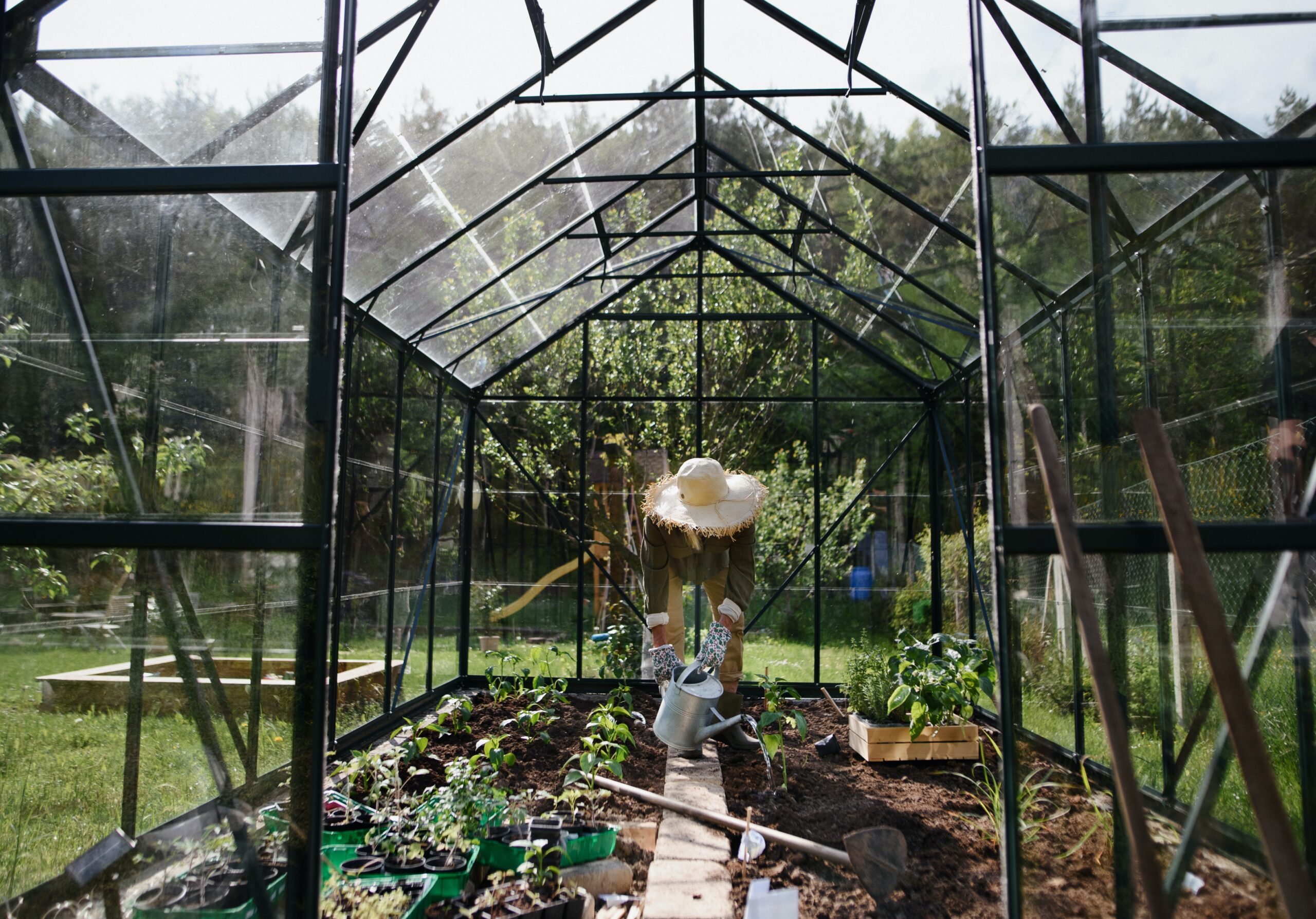Off The Grid
Achieve Self-Sufficiency with Greenhouse Gardening
Welcome, fellow adventurers, to Grits and Gear, where we’re always seeking ways to enhance our self-reliance and embrace the great outdoors. Today, we delve into the world of greenhouse gardening – an invaluable skill for achieving self-sufficiency and maintaining a sustainable lifestyle.
Building Your Greenhouse
Constructing a greenhouse is your first step toward creating an optimal environment for year-round plant growth. From affordable hoop houses to more elaborate structures, options abound. The key is to select a design that suits your needs, available space, and budget.
The Material Matters
When it comes to materials, consider factors such as insulating properties, durability, and cost. Popular options include glass, polycarbonate panels, and polyethylene film. Glass provides superior insulation but may be heavier and more expensive. Polycarbonate panels offer good insulation and durability but may require additional shading in hot climates. Polyethylene film is a cost-effective choice, providing sufficient insulation while still allowing light to pass through.
Temperature and Ventilation
Maintaining the ideal temperature is critical to greenhouse success. Optimal growing temperatures vary depending on the specific plants you’re cultivating, so it’s important to research the requirements of your chosen crops. Generally, a range of 70 to 85°F (21 to 29°C) is suitable for most vegetables and herbs.
Proper ventilation is essential to control temperature, humidity, and prevent the risk of disease. Consider installing fans, louvers, and vents to facilitate air movement. Automatic vent openers can be a helpful addition, regulating airflow by responding to temperature changes.
Plant Selection
Selecting the right plants for your greenhouse is crucial for achieving year-round yields. While you have the freedom to experiment with various crops, some popular choices for greenhouse gardening include tomatoes, peppers, cucumbers, herbs, lettuce, and microgreens.
Self-Sustainability Through Hydroponics
Embracing hydroponics within your greenhouse allows plants to thrive without soil. Instead, nutrient-rich water solutions deliver the essential elements plants need for growth. Hydroponic systems conserve water, minimize soil-borne diseases, and provide faster growth rates. Consider exploring different systems such as nutrient film technique (NFT) or deep water culture (DWC) to find the best fit for your greenhouse goals.
Lighting and Fertilization
While natural sunlight is ideal, supplemental artificial lighting may be required during colder months or in locations with limited sunlight. LED grow lights are an energy-efficient and cost-effective option, providing specific light spectrums to meet your plants’ needs.
To ensure healthy growth, consistent fertilization is crucial. Organic fertilizers are a sustainable choice, promoting soil health and minimizing the risk of chemical build-up. Compost, vermicompost (using worms), and fish emulsion are excellent options to enrich your greenhouse soil.
Pest Management
Keeping pests at bay is essential to protect your flourishing greenhouse garden. Implement integrated pest management practices, such as regular monitoring, physical barriers, and cultural control methods. Beneficial insects, like ladybugs and lacewings, can help control unwanted pests naturally. Additionally, careful attention to cleanliness, removing dead plant material, and regularly inspecting your plants can prevent pest infestations in the first place.
Harvesting and Preserving
As your plants mature, it’s time to enjoy the fruits of your labor. Regularly harvest your crops, promoting further growth and ensuring a continuous yield. Explore various preservation techniques, such as canning, drying, or freezing, to extend the shelf life of your harvest and enjoy the flavors of your greenhouse well into the winter months.
Greenhouse gardening offers us the opportunity to cultivate our own food year-round and embrace the principles of self-sufficiency. With a little determination, knowledge, and a touch of Jack Morgan’s spirit, you too can create a thriving oasis in the heart of your homestead. So, gear up, adventurers, and let’s embark on this self-sustainability journey together – one greenhouse at a time.
Remember, at Grits and Gear, we’re not just surviving; we’re thriving.
Stay resilient and keep exploring!
Disclaimer: The information provided in this article is intended for general guidance. It’s important to research and adapt the practices to suit your specific climatic conditions, plant preferences, and skill level.

Off The Grid
Protecting Vital Documents in Emergencies: A Comprehensive Guide

When the going gets tough, the tough get going. But, my friends, let me tell you, getting going isn’t just about grit and muscle. It’s about preparation. It’s about safeguarding what matters most. And today, we’re going to talk about something that many overlook in their rush to stockpile food, water, and ammo – safeguarding important documents in emergencies.
The first step in protecting your documents is understanding what you need to protect. You’ll need to secure personal identification documents such as passports, social security cards, and birth certificates. These are your proof of identity, and without them, you might find yourself in a bureaucratic nightmare. Financial documents like bank account information, property deeds, and tax records are also crucial. Lastly, don’t forget about medical records and insurance policies. In short, if it’s a document that would be a hassle to replace, it’s worth protecting.
Now, let’s move on to how to protect these vital pieces of paper. The first line of defense is a good old-fashioned safe. Look for one that is fireproof and waterproof. A safe will protect your documents from most natural disasters, but remember, it’s not foolproof. A determined thief or a catastrophic event could still compromise it.
If you’re going to use a safe, make sure it’s secured to the floor or a wall. This way, it can’t be easily removed. And, of course, don’t forget to keep the combination or key in a secure but accessible location.
Next, consider digitizing your documents. This doesn’t mean you should throw away the originals, but having digital copies can be a lifesaver. You can store these on a secure cloud service or keep them on a password-protected external hard drive. Remember, though, that digital storage isn’t infallible. Hackers, viruses, and technical failures can still pose a risk.
For an added layer of protection, consider keeping copies of your most important documents in a secure off-site location, like a safety deposit box at a bank. This way, if your home is compromised, you’ll still have access to your vital records.
Now, let’s talk about portable options. In a crisis situation, you may need to evacuate quickly. That’s when a “grab-and-go” document bag comes into play. This should be a sturdy, waterproof bag that contains copies of your most important documents. Keep it in an easily accessible location so you can grab it at a moment’s notice.
But what about those documents that are too large or unwieldy to store in a safe or a bag? Things like property deeds or vehicle titles? For these, a sealed, waterproof container stored in a secure location can do the trick.
While we’re on the topic of storage, let’s not forget about temperature control. Extreme heat or cold can damage documents, so try to store them in a place with a stable temperature.
Finally, remember to keep your documents organized. In an emergency, you don’t want to be sifting through piles of paper to find what you need. Use folders or envelopes and clearly label everything.
So, there you have it, folks. Safeguarding important documents isn’t the most thrilling aspect of emergency preparedness, but it’s one of the most crucial. It’s about more than just survival; it’s about preserving your identity, your rights, your claims, and your peace of mind. And that, my friends, is worth every bit of effort. Remember, preparation isn’t just a hobby; it’s a way of life. Stay safe, stay prepared, and as always, keep thriving.
Off The Grid
Turning Trash into Treasure: Can You Upcycle Off-the-Grid?

Upcycling is a sustainable practice that involves repurposing discarded materials into useful items, giving them a new lease on life. This eco-friendly approach can be particularly valuable for those who live off the grid or enjoy spending time in the great outdoors. By turning waste into practical tools, you not only reduce your environmental impact but also enhance your self-sufficiency and resourcefulness. In this article, we will explore several upcycling ideas that can help you create valuable off-the-grid tools from seemingly useless items.
One idea is to create a plastic bottle fish trap. Fishing is a popular activity for many outdoor enthusiasts, and a fish trap can help increase your chances of catching dinner. To make a simple fish trap, cut the top off a large plastic bottle and invert it, placing it back into the body of the bottle. Secure the two parts together with duct tape or string, and poke small holes around the bottle for water to flow through. Add some bait, such as bread or worms, and submerge the trap in a water body. The fish will swim in through the inverted opening but will have difficulty finding their way out.
Another idea is to create a tin can lantern. A lantern is an essential tool for any off-the-grid adventure, providing much-needed light during the night. To create a tin can lantern, simply clean an empty tin can and remove the label. Using a hammer and nail, punch a series of holes in a pattern of your choice around the can. Attach a wire handle to the top, and place a candle or tea light inside. The holes will cast a beautiful pattern of light, creating a functional and decorative lantern.
A glass bottle greenhouse is a valuable addition to any off-the-grid homestead, allowing you to extend your growing season and protect your plants from harsh weather. To build a glass bottle greenhouse, collect a large number of glass bottles and remove the labels. Lay a foundation for your greenhouse using bricks or other sturdy materials. Then, start stacking the bottles on their sides, using mortar or clay to hold them together. The glass bottles will create an insulated and light-filled environment, perfect for nurturing your plants.
Composting is an essential practice for sustainable living, turning organic waste into nutrient-rich soil. To create a pallet compost bin, source four wooden pallets and stand them up to create a square enclosure. Secure the corners with screws or metal brackets, and line the inside with chicken wire or mesh to contain the compost. Add your kitchen scraps, yard waste, and other organic materials, turning the pile regularly to speed up the decomposition process.
Cooking is a significant part of off-the-grid living, and having your pots and pans organized and easily accessible is crucial. To create a bicycle wheel pot rack, remove the tire and inner tube from an old bicycle wheel. Hang the wheel from the ceiling using chains or rope, and attach S-hooks around the rim. Hang your pots and pans from the hooks, creating a unique and functional pot rack.
By upcycling waste materials into useful off-the-grid tools, you not only contribute to a more sustainable lifestyle but also develop valuable skills and resourcefulness. These projects are just the beginning; with a little creativity and ingenuity, the possibilities for turning waste into practical tools are endless.
Off The Grid
Off-the-Grid Power: Guide to Harnessing Hand-Crank Devices

Electricity is a crucial part of modern life, powering our homes, gadgets, and appliances. However, access to electricity can be limited or non-existent during emergencies or outdoor adventures. This is where hand-crank devices come in. These portable, manually operated tools generate electricity, allowing you to power your essential devices and equipment when you need it most.
Hand-crank devices work by converting mechanical energy into electrical energy. When you turn the handle, gears inside the device spin a small generator, producing electricity. This simple yet effective technology has been around for decades and is still relevant today, especially for survivalists and outdoor enthusiasts.
There are various types of hand-crank devices available, each designed to serve a specific purpose. Hand-crank flashlights, for example, are an indispensable tool for any survival kit or camping trip. These flashlights generate power through a built-in dynamo, which charges an internal battery or capacitor. A few minutes of cranking can provide hours of light, making them an excellent alternative to traditional battery-powered flashlights.
Hand-crank radios are also essential during emergencies or outdoor adventures. They allow you to stay informed about weather updates, emergency broadcasts, and even provide entertainment. Most hand-crank radios come with AM/FM and NOAA weather bands, ensuring you receive vital information when you need it. Some models also include shortwave bands, allowing you to connect with stations worldwide.
Our smartphones have become an essential part of our lives, providing communication, navigation, and access to vital information. In emergency situations or during outdoor adventures, keeping your phone charged can be a challenge. A hand-crank phone charger can generate enough power to make emergency calls or send messages, ensuring you stay connected when it matters the most.
Hand-crank power banks are versatile devices that can charge multiple gadgets, including smartphones, tablets, and GPS devices. They usually come with built-in batteries that can be charged using the hand-crank, solar panels, or even by plugging into a wall socket. This makes them an excellent addition to your survival kit or camping gear, ensuring you have access to power when you need it.
Clean drinking water is essential for survival, and hand-crank water purifiers can help you achieve that. These devices use a combination of mechanical filtration and UV light to remove contaminants and kill harmful microorganisms, providing you with safe drinking water.
When choosing a hand-crank device, consider factors such as durability, power output, and ease of use. Look for devices made from high-quality materials, as they are more likely to withstand harsh conditions and last longer. Additionally, consider the device’s power output, as this will determine how quickly you can charge your gadgets or how long the device will provide light or radio reception.
Incorporating hand-crank devices into your survival kit or outdoor gear can make a significant difference in emergency situations or when you’re off the grid. These devices provide a reliable and sustainable source of electricity, ensuring you have access to essential power when you need it most. By understanding the various types of hand-crank devices available and selecting the right ones for your needs, you can be better prepared for any situation that may arise.
-

 Tactical1 year ago
Tactical1 year ago70-Year-Old Fends Off Intruder with Lead-Powered Message
-

 Tactical1 year ago
Tactical1 year agoVape Shop Employee Confronts Armed Crooks, Sends Them Running
-

 Preparedness11 months ago
Preparedness11 months agoEx-Ballerina’s Guilty Verdict Sends Tremors Through Gun-Owner Community
-

 Preparedness9 months ago
Preparedness9 months agoGood Samaritan Saves Trooper in Harrowing Interstate Confrontation
-

 Tactical1 year ago
Tactical1 year agoMidnight SUV Theft Interrupted by Armed Homeowner’s Retaliation
-

 Survival Stories2 years ago
Survival Stories2 years agoEmily’s 30-Day Experience of Being Stranded on a Desert Island
-

 Preparedness10 months ago
Preparedness10 months agoArizona Engineer’s Headless Body Found in Desert: Friend Charged
-

 Preparedness10 months ago
Preparedness10 months agoBoy Saves Dad from Bear Attack with One Perfect Shot
